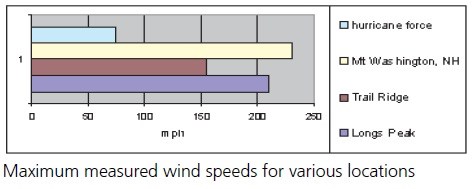Last updated: October 27, 2017
Article
Wind Research

The Question: What are the wind patterns in Rocky Mountain National Park, and can the wind be used for electrical generation?
Wind is one of the most signifi cant environmental factors influencing plants, animals, fi re, and air quality. Strong and erratic winds, characteristic of alpine and subalpine ecosystems, also affect the comfort and safety of visitors. Understanding the characteristics of wind in the park may provide valuable information to visitors or even enable the early morning prediction of severe afternoon storms. Additionally at the time this project was undertaken (1980), the park was interested in assessing the feasibility of using wind turbines to produce electricity at facilities such as the Alpine Visitor Center.
The Project: Measure wind characteristics along Trail Ridge and atop Longs Peak during the winter and summer of 1980.
A team led by D.E. Glidden and sponsored by the Rocky Mountain Nature Association established a series of wind-monitoring sites in alpine and subalpine areas. In winter they serviced these sites with some difficulty due to the danger of attempting to stand in powerful and turbulent winds. Sustained subzero temperatures and ice created an extra challenge for instrument operation. The scientists analyzed the data and compared them with similar data from locations around Colorado and the world.
The Results: The winds in Rocky Mountain National Park are exceptionally turbulent and among the world’s most severe. Wind turbines would be impractical.
With gusts reaching 201 mph on Longs Peak and 155 mph on Trail Ridge, the park hosts some of the strongest winds in the world. (For comparison, the highest surface gust ever recorded was 231 mph on Mount Washington, New Hampshire, also the site of the highest annual average wind speed in the U.S.) Wind patterns are influenced not just by elevation but also by steep slopes and narrow valleys. The park’s complex landforms result in particularly gusty winds. To quantify this type of turbulence, researchers divided the maximum hourly wind speed by the average hourly wind speed. For example, a maximum wind speed of 60 mph divided by an average hourly wind speed of 14 mph yields a gust factor of 4.28. In winter maximum turbulence occurred near sunrise and minimum turbulence after sunset. During summer winds are generally most turbulent at midday and least turbulent at sunrise. Scientists frequently recorded gusts of 74 mph or higher, a hurricane force wind, at Alpine Visitor Center both winter and summer. Average summer gust factors at the visitor center exceeded those calculated in a separate study for Mount Washington. Since wind turbines are typically shut down when wind speeds exceed 40 mph, conditions are actually too windy above treeline to rely on wind turbines for power generation. Further studies are needed to reveal the relationship of severe windstorms to topographical and climatological patterns. In the meantime alpine visitors have a unique opportunity to be standing in a breeze one moment and a hurricane-force wind the next.
This summary is based on published, peer-reviewed and/or unpublished reports available at the time of writing. It is not intended as a statement of park policy or as a definitive account of research results. For more information on the park’s research program, see www.nps.gov/romo Written by: Judy Visty Date: November 2004 Updated: January 2008 Photo credit: top, NPS-RMNP and bottom, Dave Glidden
